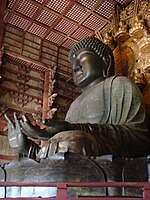Mahakala
This article needs additional citations for verification. (November 2007) |
| Mahakala | |
|---|---|
God of Time, Maya, Creation, Destruction and Power | |
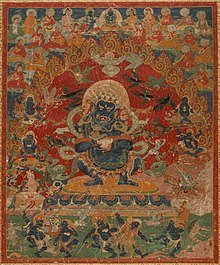 Mahākāla and companions | |
| Affiliation | Form of Shiva (Hinduism) Dharmapala (Buddhism) |
| Abode | Śmaśāna (but varies by interpretation) |
| Weapon | Khanda, Trishula, Hammer (in Japanese depictions) |
| Consort | Mahakali (Parvati) |
Mahākāla is a deity common to Hinduism and Tantric Buddhism.[1] In both religions, Mahākāla is a fierce manifestation of Shiva[1] and is the consort of the goddess Mahākālī; he most prominently appears in the Kalikula sect of Shaktism.[2][3][4] Mahākāla also appears as a protector deity known as a dharmapala in Vajrayana, Chinese Esoteric, and Tibetan Buddhism[1] (see Citipati), and also in the Chàn and Shingon traditions. He is known as Dàhēitiān and Daaih'hāktīn (大黑天) in Mandarin and Cantonese, Daeheukcheon (대흑천) in Korean, Đại Hắc Thiên in Vietnamese, and Daikokuten (大黒天) in Japanese.
Etymology[]
Mahākāla is a Sanskrit bahuvrihi of mahā "great" and kāla "time/death", which means "beyond time" or death.[5]
Tibetan: ནག་པོ་ཆེན་པོ།, THL: nak po chen po means "Great Black One". Tibetan: མགོན་པོ།, THL: gön po "Protector" is also used to refer specifically to Mahākāla.
Description[]

According to Shaktisamgama Tantra, the spouse of Mahakali is extremely frightening. Mahakala has four arms, three eyes and is of the brilliance of 10 million black fires of dissolution, dwells in the midst of eight cremation grounds. He is adorned with eight skulls, seated on five corpses, holds a trident, a drum, a sword and a scythe in his hands. He is adorned with ashes from the cremation ground and surrounded by numbers of loudly shrieking vultures and jackals. At his side is his consort symbolized as Kālī (काली, “the power of time”). Both Mahakala and Kālī (काली, “the power of time”) represent the ultimate destructive power of Brahman and they are not bounded by any rules or regulations. They have the power to dissolve even time and space into themselves and exist as Void at the dissolution of the universe. They are responsible for the dissolution of the universe at the end of Kalpa. They are also responsible for annihilating great evils and great daemons when other gods, Devas and even Trimurtis fail to do so. Mahakala and Kali annihilates men, women, children, animals, the world and the entire universe without mercy because they are Kala or Time in the personified form and Time is not bound by anything and Time does not show mercy, nor does it wait for anything or anyone.[6][7] In some parts of Odisha, Jharkhand and Dooars, (that is, in northern Bengal), wild elephants are worshiped as Mahakala.[8][9][10]
Mahakala is typically black in colour. Just as all colours are absorbed and dissolved into black, all names and forms are said to melt into those of Mahakala, symbolising his all-embracing, comprehensive nature. Black can also represent the total absence of colour, and again in this case it signifies the nature of Mahakala as ultimate or absolute reality. This principle is known in Sanskrit as "nirguna", beyond all quality and form, and it is typified by both interpretations.[11]
Mahayana Buddhism, and all schools of Tibetan Buddhism, rely on Mahakala as guardian deity. He is depicted in a number of variations, each with distinctly different qualities and aspects. He is also regarded as the emanation of different beings in different cases, namely Avalokiteśvara (Wylie: spyan ras gzigs) or Cakrasaṃvara (Wylie: ’khor lo bde mchog). Mahakala is almost always depicted with a crown of five skulls, which represent the transmutation of the five kleśās (negative afflictions) into the five wisdoms.
The most notable variation in Mahakala's manifestations and depictions is in the number of arms, but other details can vary as well. For instance, in some cases there are Mahakalas in white, with multiple heads, without genitals, standing on varying numbers of various things, holding various implements, with alternative adornments, and so on.
Six-Armed Mahakala[]
Nyingshuk came from Khyungpo Nenjor, the founder of the Shangpa Kagyu, and spread to all the lineages (Sakya, Nyingma, and Gelug) and to the Kagyu lineages. There are also terma lineages of various forms of Six-Armed Mahakala. Nyinghsuk, though derived from the Shangpa, is not the major Shangpa one; it is in a dancing posture rather than upright, and is a very advanced Mahakala practice. The White Six-Armed Mahakala (Skt: Ṣadbhūjasītamahākāla; Wylie: mgon po yid bzhin nor bu) is popular among Mongolian Gelugpas.

Mahakala, 12th century, Rubin Museum of Art
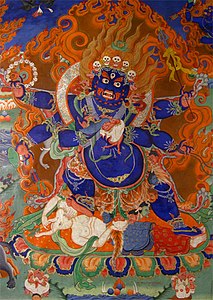
Six-Armed Mahakala, Likir Gompa, Ladakh

Tibetan Black Six-Armed Mahakala
Four-Armed Mahakala[]
Various Four-Armed Mahakalas (Skt. Chaturbhūjamahākāla, Wylie: mgon po phyag bzhi pa) are the primary protectors of the Karma Kagyu, Drikung Kagyu, Drukpa Lineage and the Nyingma of Tibetan Buddhism. A four-armed Mahakala is also found in the Nyingma school, although the primary protector of the Dzogchen (Skt: Mahasandhi) teachings is Ekajati.
Two-Armed Mahakala[]
The two-armed "Black-Cloaked Mahakala" (Wylie: mgon po ber nag chen) is a protector of the Karma Kagyu school clad in the cloak of a māntrika "warlock". His imagery derives from terma of the Nyingma school and was adopted by the Karma Kagyu during the time of Karma Pakshi, 2nd Karmapa Lama. He is often depicted with his consort, . He is often thought to be the primary protector, but he is in fact the main protector of the Karmapas specifically. Four-Armed Mahakala is technically the primary protector. Six-Armed Mahakala (Wylie: mgon po phyag drug pa) is also a common dharmapala in the Kagyu school.
Pañjaranātha Mahakala "Mahakala, Lord of the Tent", an emanation of Mañjuśrī, is a protector of the Sakya school.
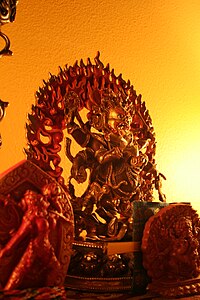
A rūpa of a six-armed Mahākāla
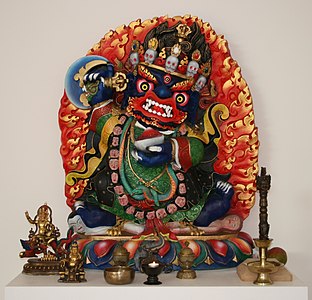
Black-Cloaked Mahākāla
Exhibit in the Asian collection of the American Museum of Natural History, Manhattan, New York City, New York, USA.
Tibetan Mahakala sculpture.

Mahakala "Protector of the Tent", Central Tibet, circa 1500.
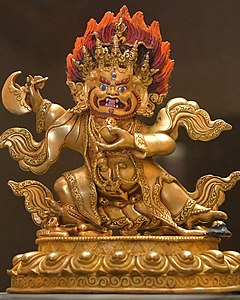
A Nepalese statue of Mahakala Bernagchen (Black Cloak Mahakala), the protector of the Karmapas.
Other forms[]
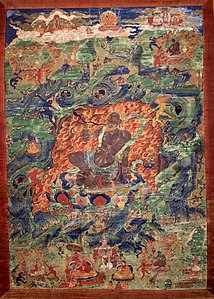
Mahakala in the Form of a Brahman

A red Mahakala
Mahakala Bhairava[]
Mahakala is also known as Mahakala Bhairava in Hinduism, and many temples in India and Nepal are dedicated solely for Mahakala Bhairava, for example at the temple in Ujjain, which is mentioned more than once by Kālidāsa. The primary temple, place of worship for Mahakala is Ujjain. Mahakala is also a name of one of Shiva's principal attendants (Sanskrit: gaṇa), along with Nandi, Shiva's mount and so is often represented outside the main doorway of early Hindu temples.
Mahakala in Japan[]

Mahakala (known as Daikokuten 大黑天) enjoys an exalted position as a household deity in Japan, as he is one of the Seven Lucky Gods in Japanese folklore.
The Japanese also use the symbol of Mahakala as a monogram. The traditional pilgrims climbing the holy Mount Ontake wear tenugui on white Japanese scarves with the Sanskrit seed syllable of Mahakala.
In Japan, this deity is variously considered to be the god of wealth or of the household, particularly the kitchen. He is recognised by his wide face, smile, and a flat black hat, in stark contrast to the fierce imagery portrayed in Tibetan Buddhist art. He is often portrayed holding a golden mallet, otherwise known as a magic money mallet, and is seen seated on bales of rice, with mice nearby (mice signify plentiful food).
Mahakala in China[]
In Chinese Buddhism, Mahakala is not commonly venerated in direct iconographic form. However, he is mentioned in many volumes of the Chinese Buddhist canon and is invoked as a protective deity in certain mantras, such as the Śūraṅgama Mantra which is popular in Chan Buddhism tradition.[12]
See also[]
References[]
- ^ Jump up to: a b c Bryson, Megan (2017). "Between China and Tibet: Mahākāla Worship and Esoteric Buddhism in the Dali Kingdom". In Bentor, Yael; Shahar, Meir (eds.). Chinese and Tibetan Esoteric Buddhism. Studies on East Asian Religions. 1. Leiden and Boston: Brill Publishers. pp. 402–428. doi:10.1163/9789004340503_019. ISBN 978-90-04-34049-7. ISSN 2452-0098.
- ^ "Mahakala the husband of Kali". Retrieved 7 July 2016.
- ^ Bhattacharya Saxena, Neela (2011). "Gynocentric Thealogy of Tantric Hinduism: A Meditation Upon the Devi". Oxford Reference. Oxford: Oxford University Press. doi:10.1093/oxfordhb/9780199273881.003.0006. (subscription or UK public library membership required)
- ^ Johnson, W. J (2009). "A Dictionary of Hinduism". Oxford Reference. Oxford: Oxford University Press. ISBN 9780198610250. (subscription or UK public library membership required)
- ^ Mookerjee, Ajit (1988). Kali: The Feminine Force. New York: Destiny
- ^ Shri Mahakala Deva
- ^ Snyder, William H. (2001). Time, Being, and Soul in the Oldest Sanskrit Sources. Global Academic Publishing. ISBN 9781586840723.
- ^ 'Pother Debota' - the deity stays not in the temple,church or gurdwara. He stays everywhere, you may meet him anywhere, around you
- ^ Bhattacharya Saxena, Neela (2011). "Gynocentric Thealogy of Tantric Hinduism: A Meditation Upon the Devi". Oxford Reference. Oxford: Oxford University Press. doi:10.1093/oxfordhb/9780199273881.003.0006. (subscription or UK public library membership required)
- ^ Johnson, W. J (2009). "A Dictionary of Hinduism". Oxford Reference. Oxford: Oxford University Press. ISBN 9780198610250. (subscription or UK public library membership required)
- ^ Bowker, John (2000). "The Concise Oxford Dictionary of World Religions". Oxford Reference. Oxford: Oxford University Press. doi:10.1093/acref/9780192800947.001.0001. (subscription or UK public library membership required)
- ^ Śūraṅgama Sūtra Translation Committee of the Buddhist Text Translation Society, 2009, p. xviii.
- ^ Los Angeles County Museum of Art, Pratapaditya Pal. (1988). Indian Sculpture: 700-1800. pp. 180.
Further reading[]
- Ladrang Kalsang (author), Pema Thinley (trans.) The Guardian Deities of Tibet. Delhi: 1996 reprinted 2003, Winsome Books India, ISBN 81-88043-04-4
- Linrothe, Rob (1999) Ruthless Compassion: Wrathful Deities in Early Indo-Tibetan Esoteric Buddhist Art London: Serindia Publications. ISBN 0-906026-51-2
- De Nebesky-Wojkowitz, Rene. (1956) Oracles and Demons of Tibet. Oxford University Press. Reprint Delhi: Books Faith, 1996. ISBN 81-7303-039-1. Reprint Delhi: Paljor Publications, 2002. ISBN 81-86230-12-2.
- William Stablein. Healing Image: The Great Black One Berkeley-Hong Kong: SLG Books, 1991. ISBN 0-943389-06-2.
- William Stablein. The Mahakalatantra: ATheory of Ritural Blessings and Tantric Medicine Ph.D. Dissertation, Columbia University, 1976.
- Emi Matsushita, Iconography of Mahākāla. M.A. Thesis, The Ohio State University, 2001. Link of full-length Thesis http://rave.ohiolink.edu/etdc/view?acc_num=osu1141933891
- Martin Gimm Zum mongolischen Mahākāla-Kult und zum Beginn der Qing-Dynastie—die Inschrift Shisheng beiji von 1638 (2000/01)
- Elliot Sperling, rTsa mi lo-ts-ba Sangs-rgyas grags-pa and the Tangut Background to Early Mongol-Tibetan Relations, Tibetan Studies: Proceedings of the 6th Seminar of the International Association for Tibetan Studies, Fagernes, 1992. vol. 2, Oslo: The Institute for Comparative Research in Human Culture, 1994, pp. 801–824
- Todd Lewis. scribd. com/doc/13280877/Popular-Buddhist-Texts-From-Nepal-Narratives-and-Rituals-of-Newar-Buddhism Popular Buddhist Texts From Nepal Narratives and Rituals of Newar Buddhism. NY: SUNY Publication, 2000.
- The Śūraṅgama Sūtra Translation Committee of the Buddhist Text Translation Society. (2009). The Śūraṅgama Sūtra: With Excerpts from the Commentary by the Venerable Master Hsüan Hua: A New Translation. Ukiah, CA, USA: Buddhist Text Translation Society.
External links[]
- Outline of Mahakala Iconography - at HimalayanArt.org
- Buddhist Protector: Mahakala (All Forms) - at HimalayanArt.org
- Khandro.net: Mahakala
- Mahakala Thangka Painting - Six-armed White Mahakala manifestation
- Śūraṅgama Mantra - Mantra invoking Mahakala as a protective deity
- Agricultural gods
- Buddhist tantras
- Dharmapalas
- Chinese deities
- Chinese gods
- Fortune gods
- Japanese gods
- Tibetan Buddhist practices
- Tantra
- Forms of Shiva
- Time and fate gods
- Creator gods
- Destroyer gods
- Herukas
- Wrathful deities












